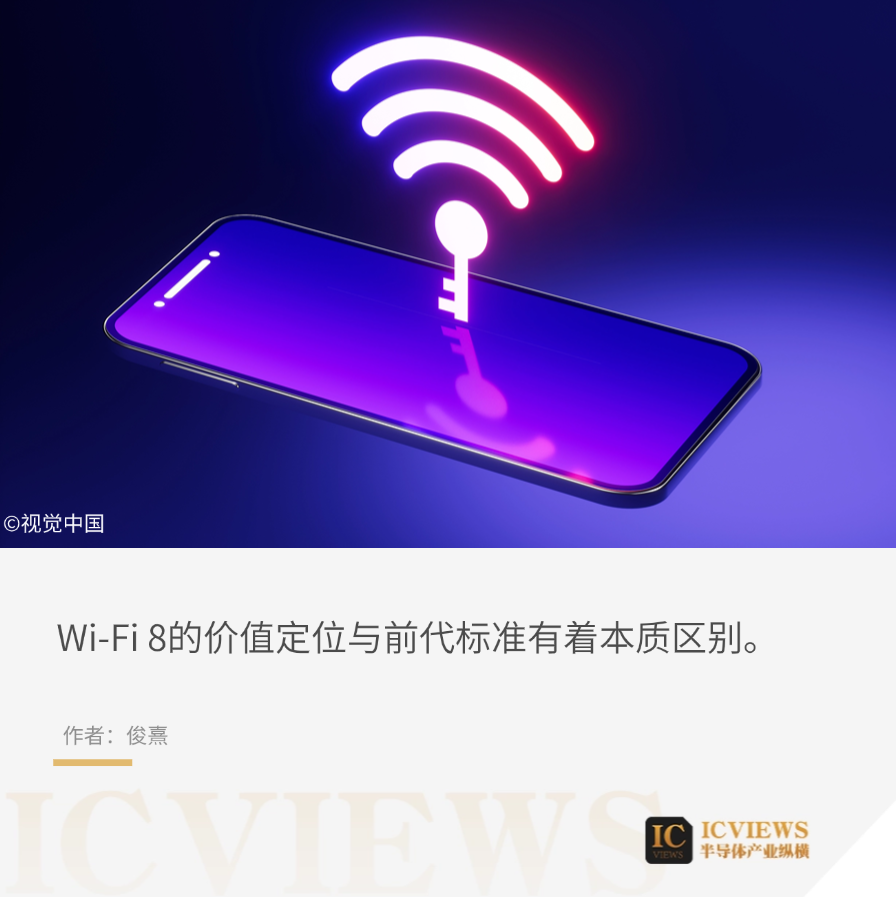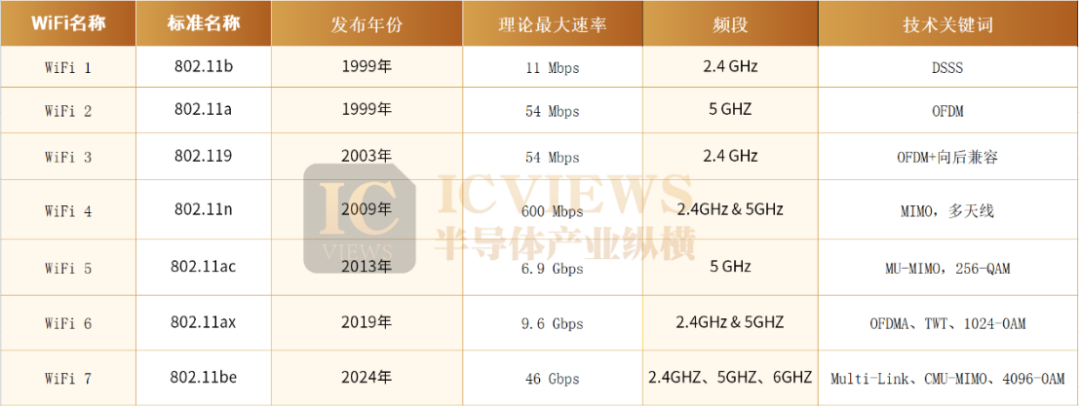Wi-Fi 8: A Veteran with a New Lease on Life
![]() 08/18 2025
08/18 2025
![]() 646
646

On August 4, Qualcomm China officially announced that the IEEE 802.11bn standard is anticipated to be finalized by 2028, laying the groundwork for Wi-Fi 8.
In the article, Qualcomm China offers a forward-thinking glimpse into Wi-Fi 8's key features, definitions, and infrastructure. Wi-Fi 8 aims to prioritize reliable performance in complex real-world environments, delivering exceptional connectivity even in scenarios characterized by network congestion, susceptibility to interference, and high mobility.
The rapid intensification of competition in the Wi-Fi arena is striking. Many are still to adopt Wi-Fi 7, yet major players are already eyeing Wi-Fi 8.
Moreover, while Wi-Fi 6 and Wi-Fi 7 have primarily focused on parameters such as network speed, frequency bands, and bandwidth, Wi-Fi 8 shifts gears to emphasize stability and reliability.
What does this shift signify? What is the current market application landscape of Wi-Fi 7? Will Wi-Fi 8 emerge as a superior replacement for Wi-Fi 7 or forge new application paths?
01
From Wi-Fi 1 to Wi-Fi 7
Since its initial standardization in 1997, wireless network technology has undergone seven significant updates. The terms "Wi-Fi 1" to "Wi-Fi 7" are simplified naming conventions adopted by the industry for consumer understanding, aligning with the IEEE 802.11 series of wireless LAN protocol standards.
Each Wi-Fi generation corresponds to a sub-version of 802.11, with each evolution bringing notable changes in speed, frequency bands, stability, and security.

Wi-Fi 1 (802.11b), the first widely commercially adopted Wi-Fi standard, debuted in 1999, enabling basic wireless network access. It operates in the 2.4GHz frequency band with a theoretical maximum speed of 11Mbps. However, its low speed, susceptibility to interference from other household appliances, and limited security (WEP encryption) have rendered it obsolete.
Wi-Fi 2 (802.11a) was released alongside 802.11b but took a different technical path. It utilized the less congested 5GHz frequency band and more efficient OFDM technology, offering data transmission rates of up to 54Mbps. However, due to the physical characteristics of 5GHz signals, its coverage and penetration capabilities are inferior to 2.4GHz, and the high cost of early devices contributed to its lower adoption compared to 802.11b.
Wi-Fi 3 (802.11g) was introduced in 2003, effectively blending the advantages of the first two generations. It applied the OFDM technology of 802.11a to the more widely adopted 2.4GHz frequency band, achieving a comparable 54Mbps rate to 802.11a while maintaining backward compatibility with 802.11b devices. This feature quickly propelled it to market dominance, driving the popularity of home wireless networks.
Wi-Fi 4 (802.11n) marked a significant leap in Wi-Fi performance. By introducing MIMO (Multiple Input Multiple Output) technology for the first time, it utilized multiple antennas to simultaneously transmit and receive data, significantly boosting throughput and connection stability, with a theoretical maximum speed of 600Mbps. It was also the first standard to support dual-band operation on both 2.4GHz and 5GHz, providing reliable support for high-bandwidth applications such as HD video streaming and online gaming.
Wi-Fi 5 (802.11ac), released in 2013, focused on enhancing performance in the 5GHz frequency band. By supporting wider channel bandwidths (e.g., 80MHz and 160MHz) and introducing more efficient modulation methods (256-QAM), it further increased transmission rates, with theoretical values reaching 6.9Gbps. More importantly, it introduced MU-MIMO (Multi-User MIMO) technology, enabling routers to simultaneously send data to multiple devices, improving network efficiency in multi-device scenarios to meet demands such as 4K video streaming.
Wi-Fi 6 (802.11ax) was introduced in 2019, shifting its focus from merely increasing peak speed to optimizing overall network efficiency and capacity. The key technology OFDMA (Orthogonal Frequency Division Multiple Access) divides wireless channels into smaller resource units, which can be allocated to multiple devices for simultaneous use, significantly reducing latency and collisions in high-density environments. Additionally, TWT (Target Wake Time) technology effectively reduces power consumption for IoT devices.
Wi-Fi 7 (802.11be), the latest generation standard, began commercialization in 2024, aiming to meet the needs of future cutting-edge applications. Its core innovations include support for 320MHz ultra-wide channels, the adoption of more efficient 4096-QAM modulation, and the transformative MLO (Multi-Link Operation) technology. MLO allows devices to establish and use data links simultaneously on multiple frequency bands, enabling rate aggregation or seamless switching, thereby achieving extremely high throughput and ultra-low latency. These features make it capable of supporting applications with stringent network performance requirements, such as 8K video streaming, AR/VR, cloud gaming, and industrial automation.
02
Wi-Fi 7: A Bit of Awkwardness
Currently, the market position of Wi-Fi 7 is uncertain. Looking ahead, the benefits of Wi-Fi 6 are far from exhausted, and Wi-Fi 8 is already on the horizon. The commercialization of Wi-Fi 7 is progressing, but there is considerable debate about its practicality.
On the positive side, since certification opened in January 2024, the global commercialization of Wi-Fi 7 has accelerated. According to Omdia data, as of the first quarter of 2025, 23% of global telecom operators have launched Wi-Fi 7-related products and services. Meanwhile, Wi-Fi 7 chips from international giants like Qualcomm and Broadcom cover specifications ranging from 3Gbit/s to 10Gbit/s, catering to different bandwidth needs from consumer to enterprise levels, providing stable support for downstream device manufacturing. Counterpoint predicts that the global Wi-Fi chip market will grow by 12% year-on-year in 2025, with Wi-Fi 6, Wi-Fi 6E, and Wi-Fi 7 devices accounting for 43% of the total.
In terms of product ecology, various Wi-Fi 7 devices have emerged in the market. Vendors such as Huawei, H3C, and Ruijie Networks have launched AP products suitable for different environments. The consumer-grade router market already boasts more than a dozen products across a wide price range, and mainstream flagship smartphones are starting to integrate Wi-Fi 7 functionality, providing a hardware foundation for technology application.
Regarding specific application implementations, Wi-Fi 7 has been piloted in multiple key areas such as healthcare, transportation, manufacturing, and large campuses. For example, in healthcare, Beijing Union Medical College Hospital utilizes Wi-Fi 7 to support real-time transmission of surgical robots and 4K medical images. In large transportation hubs like Shanghai Hongqiao Railway Station, its network provides stable throughput exceeding 1Gbps for HD monitoring and passenger roaming. In smart manufacturing workshops, MLO technology ensures stable control of AGV unmanned transport vehicles. Additionally, China Film Studios and some universities have met professional needs such as HD production and high-density teaching through large-scale deployment of APs.
However, Wi-Fi 7 also faces its own challenges.
First, the most critical constraint stems from the limitation of spectrum resources. Currently, the 6GHz frequency band has not been officially allocated for Wi-Fi use in China, directly preventing the activation of Wi-Fi 7's most revolutionary feature: the 320MHz ultra-wide channel. Therefore, Wi-Fi 7 devices sold in the Chinese market have their maximum performance suppressed, and the actual increase in transmission capacity is limited compared to high-end Wi-Fi 6 devices, making it difficult to create an "experience gap" that drives large-scale user upgrades. This fundamentally weakens Wi-Fi 7's core attractiveness in the consumer market.
Second, ecology and cost pose barriers to popularization. On one hand, some core technologies of Wi-Fi 7 are not yet fully mature. For example, MLO technology still suffers from insufficient terminal compatibility, and the 4096-QAM high-order modulation technology has extremely high signal quality requirements, with its actual effect limited by the distance between the terminal and the AP. On the other hand, the manufacturing cost of Wi-Fi 7 devices is still higher than that of previous-generation products. Without achieving a disruptive improvement in performance experience, most users are reluctant to pay higher procurement costs for limited gains. Coupled with the fact that Wi-Fi 6 terminals still occupy a significant market share, the bidirectional upgrade of devices and networks requires a transition period, further slowing down the commercialization pace.
Furthermore, the deployment environment poses a significant challenge for Wi-Fi 7. Industry experts point out that Wi-Fi 7's true technical advantages are primarily evident in enterprise-grade and industrial-grade application scenarios with stringent network performance requirements, such as multi-device coordination in smart factories, real-time data transmission in telemedicine, and large-bandwidth, low-latency interactions for XR devices. However, when deploying Wi-Fi 7 in these professional environments, enterprises often encounter three costly mistakes: neglecting the upgrade of wired backbone networks, which can't match Wi-Fi 7's high throughput; ignoring power supply requirements in harsh environments, leading to degraded or failed AP performance; and overlooking the complex radio frequency (RF) environment in industrial sites, where metal structures and mechanical equipment cause significant signal interference, severely impacting network stability without professional RF planning.
03
Wi-Fi 8: A Game Changer
Qualcomm asserts that Wi-Fi 8 aims to go a step further, not only surpassing Wi-Fi 7 but also achieving quantifiable performance leaps in the most challenging scenarios. According to the IEEE scope document, Wi-Fi 8 will bring:
At least a 25% increase in throughput in complex signal environments. A 25% reduction in latency at the 95th percentile of delay distribution. A 25% reduction in packet loss, especially during roaming between access points.
As analyzed in the previous section, Wi-Fi 7's dilemma largely stems from the significant performance degradation of its advanced technologies in congested, interference-prone, and multi-device mobile scenarios. Wi-Fi 8 attempts to address these issues by introducing a set of intelligent coordination mechanisms that revolutionize network operations.
Wi-Fi 8's multi-access point coordination technology enables previously competing APs to collaborate, minimizing mutual interference and enhancing the overall network's actual throughput through intelligent negotiation of transmission power and joint adjustment of signal beams.
Furthermore, to address the efficiency and fairness of resource allocation, Wi-Fi 8 introduces a more refined scheduling mechanism that prioritizes high-priority tasks while avoiding network lag for low-priority applications. In terms of mobility, Wi-Fi 8's concept of a "single mobility domain" ensures seamless roaming between different APs, guaranteeing connection continuity.
These technological innovations differentiate Wi-Fi 8's value proposition from previous standards, expanding its application scenarios from ordinary consumer-grade to areas with stringent network requirements, particularly showing great potential in the following three scenarios:
First, in the realm of industrial automation, Wi-Fi 8's ultra-high reliability enables it to handle core production tasks that previously relied solely on wired networks. In smart factories, collaborative robots, AGVs, and AI quality inspection systems require uninterrupted low-latency data streams for precise coordinated operations. Wi-Fi 8's multi-AP coordination and seamless roaming capabilities ensure that these mobile devices maintain stable connections across vast factory premises, preventing production disruptions caused by signal switching or interference. In smart hospitals, it can stably support millisecond-level operation command transmission for remote surgical robots, real-time retrieval of HD medical images, and data aggregation from large-scale IoT medical sensors, truly elevating Wi-Fi from a convenience network to a critical business infrastructure.
Second, Wi-Fi 8 is seen as a catalyst for extended reality (XR) applications, potentially breaking through key adoption barriers. One of the best paths for XR devices to achieve lightness, long battery life, and affordable prices is to offload intensive computing tasks to the cloud or local edge servers. This model places extreme demands on wireless networks: it must have ultra-high bandwidth for transmitting HD images while maintaining ultra-low and stable latency to avoid causing motion sickness in users. While Wi-Fi 7 boasts high speeds, its stability in complex environments is still insufficient. Wi-Fi 8, designed for deterministic connectivity with wired-like reliability, will make "cloud XR" possible, thereby birthing truly immersive and affordable XR applications and driving the entire ecosystem into a positive cycle.
In high-density public venues such as airports, stadiums, and transportation hubs, Wi-Fi 8's advanced intelligent coordination and resource management capabilities will drastically alleviate network congestion, even when thousands of users access the network simultaneously. Whether users are sharing videos, utilizing AR navigation, or engaging in immersive experiences, the network no longer involves mere resource contention. Instead, through intelligent scheduling, it ensures a stable and seamless connection for each user. Concurrently, vital security systems, video surveillance, and emergency communications in these locations can also benefit from reliable network support during peak usage times.
04
Conclusion
For seasoned professionals, stability reigns supreme. While Wi-Fi 8 maintains largely similar specifications to Wi-Fi 7 in terms of maximum channel bandwidth, frequency bands, maximum physical rate, and modulation methods, it places a heavier emphasis on delivering a more efficient and stable connection in complex and dynamic network environments. This shift is quite intuitive. Wi-Fi 7, with its relentless accumulation of parameters, faced criticisms such as "Will Wi-Fi 7 become the Wi-Fi standard with the biggest disappointment?", "Would you still opt for a downgraded Wi-Fi 7 router?", and "Wi-Fi 7's experience falls short of expectations" during its rollout. When the ecosystem and environment are mismatched, higher performance merely escalates costs, fostering user dissatisfaction.
Wi-Fi 8 thus underscores the significance of stability over sheer speed. Once stability is attained, a myriad of new application scenarios will arise. After all, AI and XR represent significant future trends. On the journey towards this future, we undeniably need a seasoned pro.








